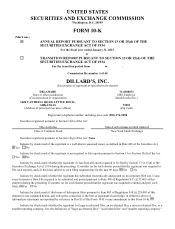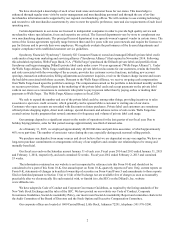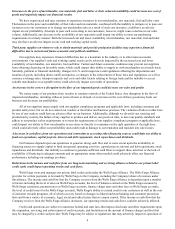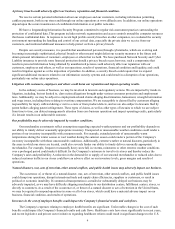Dillard's 2014 Annual Report Download - page 12
Download and view the complete annual report
Please find page 12 of the 2014 Dillard's annual report below. You can navigate through the pages in the report by either clicking on the pages listed below, or by using the keyword search tool below to find specific information within the annual report.7
healthcare system. Many of our employees who currently choose not to participate in our healthcare plans may find it more
advantageous to do so as a result of recent changes to healthcare laws in the United States. Such changes include potential
penalties on persons for not obtaining healthcare coverage and employees being ineligible for certain healthcare subsidies if
such employee is eligible and offered qualifying and affordable healthcare coverage under an employer's plan. If a large portion
of eligible employees who currently choose not to participate in our plans choose to enroll as a result of the law change, it may
significantly increase our healthcare coverage costs, or we may not be able to offer competitive health care benefits to attract
and retain employees; either of which could have an adverse effect on our reputation and have a negative impact on our
financial results.
The Company depends on its ability to attract and retain quality employees, and failure to do so could adversely affect our
ability to execute our business strategy and our operating results.
The Company's business is dependent upon attracting and retaining quality employees. The Company has a large number
of employees, many of whom are in entry level or part-time positions with historically high rates of turnover. The Company's
ability to meet its labor needs while controlling the costs associated with hiring and training new employees is subject to
external factors such as unemployment levels, prevailing wage rates, minimum wage and health reform legislation and
changing demographics. In addition, as a complex enterprise operating in a highly competitive and challenging business
environment, the Company is highly dependent upon management personnel to develop and effectively execute successful
business strategies and tactics. Any circumstances that adversely impact the Company's ability to attract, train, develop and
retain quality employees throughout the organization could adversely affect the Company's business and results of operations.
Variations in the amount of vendor allowances received could adversely impact our operating results.
We receive vendor allowances for advertising, payroll and margin maintenance that are a strategic part of our operations.
A reduction in the amount of cooperative advertising allowances would likely cause us to consider other methods of advertising
as well as the volume and frequency of our product advertising, which could increase/decrease our expenditures and/or
revenue. Decreased payroll reimbursements would either cause payroll costs to rise, negatively impacting operating income, or
cause us to reduce the number of employees, which may cause a decline in sales. A decline in the amount of margin
maintenance allowances would either increase cost of sales, which would negatively impact gross margin and operating
income, or cause us to reduce merchandise purchases, which may cause a decline in sales.
Our operations are dependent on information technology systems, and disruptions in those systems could have an adverse
impact on our results of operations.
Our operations are dependent upon the integrity, security and consistent operation of various systems and data centers,
including the point-of-sale systems in the stores, our Internet website, data centers that process transactions, communication
systems and various software applications used throughout our Company to track inventory flow, process transactions and
generate performance and financial reports. The Company's computer systems are subject to damage or interruption from
power outages, computer and telecommunications failures, computer viruses, cyberattack or other security breaches,
catastrophic events such as fires, floods, earthquakes, tornadoes, hurricanes, acts of war or terrorism, and usage errors by the
Company's employees. If the Company's computer systems are damaged or cease to function properly, the Company may have
to make a significant investment to repair or replace them, and the Company may suffer loss of critical data and interruptions or
delays in its operations in the interim. Any material interruption in the Company's computer systems could adversely affect its
business or results of operations. Additionally, to keep pace with changing technology, we must continuously provide for the
design and implementation of new information technology systems and enhancements of our existing systems. We could
encounter difficulties in developing new systems or maintaining and upgrading existing systems. Such difficulties could lead to
significant expenses or to losses due to disruption in business operations.
The percentage-of-completion method of accounting that we use to recognize contract revenues for our construction
segment may result in material adjustments, which could result in a charge against our earnings.
Our construction segment recognizes contract revenues using the percentage-of-completion method. Under this method,
estimated contract revenues are recognized by applying the percentage of completion of the project for the period to the total
estimated revenues for the contract. Estimated contract losses are recognized in full when determined. Total contract revenues
and cost estimates are reviewed and revised at a minimum on a quarterly basis as the work progresses and as change orders are
approved. Adjustments based upon the percentage of completion are reflected in contract revenues in the period when these
estimates are revised. To the extent that these adjustments result in an increase, a reduction or an elimination of previously
reported contract profit, we are required to recognize a credit or a charge against current earnings, which could be material.
























